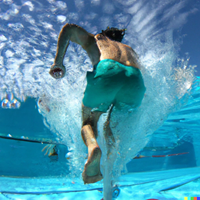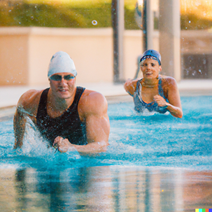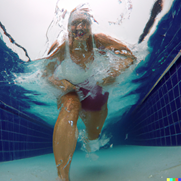How to Maximize Your Pool Running Workout
Do you want to get a great cardio workout without the risk of impact injury? Pool running might be the perfect solution! Pool running is an innovative form of exercise that can provide you with the same cardiovascular and muscular benefits as outdoor running, but without the impact on your joints. There is greater resistance depending on the depth you are in, your running tempo, and what exercise equipment you choose.

Pool running is a simple yet effective form of exercise that requires minimal equipment. All you will need is a swimming pool and some basic pool exercise gear like a swimsuit or form-fitting workout garments. You might also need a pool noodle or a belt, and perhaps a pair of arch-supporting water shoes, depending on the depth of pool running you wish to do. Adding some handheld pool exercise equipment can really amp up your cardio workout.
There are several different pool running techniques you can use to maximize your workout. Running in place underwater is a great way to get your heart rate up and burn some calories.
Start with a warm-up. In general, dynamic stretching such as marching, jacks, leg curls, and lunges for 5 to 10 minutes is a great way to get started.
End with a cool-down. Depending on the temperature of your pool, you can do some static stretches (warm water) or dynamic stretches (cold water).
Use a pool noodle or pool belt for flotation and/or extra resistance to increase cardio. Just use your arms along with your legs for a more aerobic full-body workout.

Change up your water depth. Running in place in different depths dramatically changes the outcome and your experience.
For instance, if you want vigorous aerobic exercise, you will want to run fully suspended in the deep water. That means your feet don’t touch the pool floor. Fully suspended exercises like deep water running will need flotation equipment. You may want to adjust your depth so that you can feel your feet underneath you for better balance.
As you get shallower in the water, gravity starts having a stronger influence on your body. This can have the effect of improving the strength of your ankles and feet as you rebound. You may not want to run in place, but rather travel across the pool. Traveling across the pool is more challenging due to the forces of water.
One of the laws of water is that the faster something moves, the greater the resistance. Therefore, if you run to a tempo that is 76 bpm (beats per minute), you will find your exertion is moderate. Do the same exercise at 132 bpm, and you’ll find that your exertion is much more intense compared to your exertion on land.
Increasing the surface area has the same intensity-building effect. This is what pool exercise equipment is for. Finding your sweet spot is a bit of an experimental process.
Pool exercise equipment comes in three forms: flotation (buoyant) equipment, resistance (drag) equipment, or both forces (combo). Dumbbells are very common and are held in your hands while running. Some are made of foam, have rounded edges, and are primarily used for their flotation resistance. Combo dumbbells, such as triangle-shaped, give you resistance when you push against the flat side. Resistance handbells and paddles are made out of hard plastic and provide no flotation resistance. Their purpose is to increase the surface area that you are working against (drag).
They come in different sizes. For running, choose smaller sizes over larger sizes and pick up the tempo of your run when you feel you are ready to take it to the next level.
Don’t use any handheld pool equipment while running if you have shoulder, elbow, or wrist issues; use webbed gloves instead. Bathing-suit material gloves are great for adding resistance. They are small, light-weight, and travel easily.

 Without using a flotation belt or pool noodle, you will be struggling to keep your head above water, decreasing the efficiency of the exercise and your enjoyment of pool running. The preferred equipment is a belt. It provides enough flotation so you’re not struggling and the greatest mobility. Straddling a pool noodle will keep you afloat but doesn’t give you the control or the abdominal activation of a belt.
Without using a flotation belt or pool noodle, you will be struggling to keep your head above water, decreasing the efficiency of the exercise and your enjoyment of pool running. The preferred equipment is a belt. It provides enough flotation so you’re not struggling and the greatest mobility. Straddling a pool noodle will keep you afloat but doesn’t give you the control or the abdominal activation of a belt.
Ankle cuffs provide the same benefits as handheld equipment. Use either flotation cuffs or resistance cuffs to make your run more challenging.
As with any form of exercise, safety should be your first priority. It is a common assumption that you can’t hurt yourself pool running. However, poor posture and bad body alignment will strain the wrong muscles. Therefore, keep your powerful posture, engage your core to stabilize your spine, and make sure to listen to your body if you start to feel any pain or discomfort. Wearing water shoes increases your enjoyment and safety in pool jogging. They protect your skin plus help ensure your arches and ankles are in proper alignment.
Pool running is a great way to get a low-impact cardio workout without the risk of joint or muscle injury. Not only is it a great way to stay in shape, but it can also be a fun and relaxing way to enjoy the water. With the proper technique and safety measures, you can maximize your workout and reap the benefits of pool running.
If you are looking for more variation in your pool running routine, you may want to consider using the Ability Fix app. This app includes a variety of pool running exercises, as well as helpful instructional videos. All exercises and workouts are categorized by a person’s mobility level. With the help of the Ability Fix app, you can take your pool running to the next level.